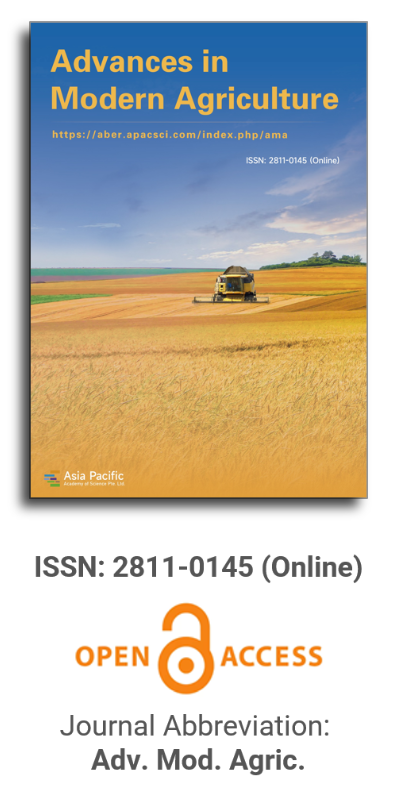


Effects of LED light intensity on purple leaf lettuce seedlings
Vol 3, Issue 2, 2022
VIEWS - 7213 (Abstract)
Download PDF
Abstract
To explore the light intensity suitable for the growth of purple leaf lettuce seedlings in plant factories and greenhouses, the effects of light intensity of 6000, 12,000, 18,000, 24,000, and 30,000 lx on growth morphology, nutritional quality, photosynthetic pigment, and photosynthetic characteristics of purple leaf lettuce seedlings were studied with ‘Beizisheng 3’ as the experimental material under the condition of white light quality unchanged. The results showed that under a light intensity of 30,000 lx, purple leaf lettuce seedlings grew well, and the biomass, chlorophyll a content, chlorophyll b content, carotenoid content, total chlorophyll, soluble protein content, soluble sugar content, vitamin C content, anthocyanin content, net photosynthetic rate, transpiration rate, and stomatal conductance were the largest, while the nitrate content and intercellular CO2 concentration were the lowest. However, chlorophyll b content, carotenoid content, soluble protein content, and transpiration rate had no significant difference compared with those under 24000 lx light intensity, and the plant height was the highest under 24,000 lx light intensity. Under the condition of white light quality, the most suitable light intensity for the growth of purple leaf lettuce seedlings is 30,000 lx.
Keywords
References
- Zhu X, Liu M. A preliminary discussion on the mechanism of the effect of light on plant growth. Lamps and Lighting 2016; 40(1): 1–4.
- Chen X, Chen Q. Research progress on the physiology of plants under low light stress. Northern Horticulture 2014; 6: 183–187.
- Xu G. Effects of light environment regulation on plant growth and development. Biotechnology World 2015; 12: 214.
- He J, Ming M, Lu D, et al. Research progress on the effects of low light stress on plant physiological characteristics. China Agricultural Science Bulletin 2018; 34(6): 123–130.
- Wen J, Meng L, Zhang J, et al. Research progress on the effects of weak light on plant photosynthetic characteristics. Jiangsu Agricultural Science 2014; 42(7): 22–24.
- Wang Q, Liu J, Liu W. Effects of LED red and blue light intensity patterns on the growth and yield of hydroponic lettuce. Chinese Journal of Lighting Engineering 2021; 32(2): 1–5.
- He B, Zhu N, Qi C, et al. Screening test of lettuce varieties. Vegetables 2021; 6: 7981.
- Liu K, Song Y, Zhang L, et al. Comprehensive comparison of the quality of purple-leaf lettuce and green-leaf lettuce. Changjiang Vegetables 2021; 6: 51–53.
- Fang S. Effects of Light Intensity and Nutrient Solution Concentration on the Growth and Nutrient Use Efficiency of Hydroponic Lettuce. Northwest A&F University; 2018.
- Liu W, Liu Y. Construction and application of light formula for LED smart plant factory. China Lighting 2017; 10: 1–3.
- Xing A, Cui H, Yu X, et al. Effects of light quality and photoperiod on plant growth and development. Northern Horticulture 2018; 3: 163–172.
- Fu Y, Li H, Yu J, et al. Interaction effects of light intensity and nitrogen concentration on growth, photosyn-thetic characteristics and quality of lettuce (Lactuca sativa L. var. youmaicai). Scientia horticulturae 2017; 214: 51–57.
- Viršilė A, Brazaitytė A, Vaštakaitė‐Kairienė V, et al. Lighting intensity and photoperiod serves tailoring nitrate assimilation indices in red and green baby leaf lettuce. Journal of the Science of Food and Agriculture 2019 99(14): 6608–6619. doi: 10.1002/jsfa.9948
- Ren X, Zhang C, Zhang Y, et al. Effects of different red and blue LED light intensities on the growth and nutritional quality of purple-leaf lettuce. North China Agricultural Journal 2019; 34(6): 89–96.
- Zhang T. Effects of Different LED Light Qualities and Combinations on the Physiological Basis and Nutritional Quality of Leaf Lettuce. Henan Agricultural University; 2018.
- Liu H, Jiang Q. Effects of different LED light qualities on the growth of tomato seedlings. Northern Horticulture 2020; 18: 38–42.
- Liu X, Jiao X, Xu Z, et al. Effects of different red and blue LED light intensities on the growth and antioxidant enzyme activities of cherry tomato seedlings. Journal of Nanjing Agricultural University 2015; 38(5): 772–779.
- Yan X, Liu Z, Sun L, et al. Effects of different light intensities on the growth and field characters of pumpkin seedlings. Northern Horticulture 2021; 15: 7–13.
- Jiang S, Dang K, Zhang Y, et al. Effects of light intensity, temperature and continuous light on nitrate accumulation in hydroponic lettuce. Changjiang Vegetables 2014; 12: 36–39.
- Wei J, Song S, Liu H. Research progress on the effects of red and blue light on vegetable quality. Chinese Journal of Lighting Engineering 2018; 29(4): 1–7,30.
- Ji J, Li C, Ding H, et al. Effects of light intensity and photoperiod on the growth and quality of red-leaf lettuce. Chinese Journal of Lighting Engineering 2019; 30(6): 163–166.
- Zhou Q, Wu Y, Xu W, et al. Effect of light intensity on the accumulation of nitrate in lettuce. Agricultural Mechanization Research 2009; 31(1): 189–192.
- Wang Z, Song F, Xu Z, et al. Effects of different red and blue LED light intensity on the growth and quality of leaf lettuce. China Vegetables 2011; 16: 44–49.
- Gao Y, Li Q, Liu B, et al. Effects of different light quality ratios on photosynthetic characteristics and quality of purple lettuce. Chinese Journal of Applied Ecology 2018; 29(11): 3649–3657.
- Kwack Y, Kim KK, Hwang H, et al. Growth and quality of sprouts of six vegetables cultivated under different light intensity and quality. Horticulture, Environment, and Biotechnology 2015; 56: 437–443. doi: 10.1007/s13580-015-1044-7
Supporting Agencies
Copyright (c) 2022 Lvye Dai, Xin Zhang, Yingzi Teng, Yiyin Gu, Li Chen, Xiaoping Kong, Yingyan Han

This work is licensed under a Creative Commons Attribution 4.0 International License.

This site is licensed under a Creative Commons Attribution 4.0 International License (CC BY 4.0).

Prof. Zhengjun Qiu
Zhejiang University, China

Cheng Sun
Academician of World Academy of Productivity Science; Executive Chairman, World Confederation of Productivity Science China Chapter, China
Indexing & Archiving
In the realm of modern agriculture, the integration of cutting-edge technologies is revolutionizing the way we approach sustainable farming practices. A recent study published in Advances in Modern Agriculture titled "Classification of cotton water stress using convolutional neural networks and UAV-based RGB imagery" has garnered significant attention for its innovative approach to precision irrigation management. Conducted by researchers from Institute of Data Science and the AgriLife Research and Extension Center of Texas A&M University (authors's information is below). This study introduces a novel method for classifying cotton water stress using unmanned aerial vehicles (UAVs) and convolutional neural networks (CNNs), offering a powerful solution for optimizing water use in agriculture.
Modern agricultural technology is evolving rapidly, with scientists collaborating with leading agricultural enterprises to develop intelligent management practices. These practices utilize advanced systems that provide tailored fertilization and treatment options for large-scale land management.
This journal values human initiative and intelligence, and the employment of AI technologies to write papers that replace the human mind is expressly prohibited. When there is a suspicious submission that uses AI tools to quickly piece together and generate research results, the editorial board of the journal will reject the article, and all journals under the publisher's umbrella will prohibit all authors from submitting their articles.
Readers and authors are asked to exercise caution and strictly adhere to the journal's policy regarding the usage of Artificial Intelligence Generated Content (AIGC) tools.
Asia Pacific Academy of Science Pte. Ltd. (APACSCI) specializes in international journal publishing. APACSCI adopts the open access publishing model and provides an important communication bridge for academic groups whose interest fields include engineering, technology, medicine, computer, mathematics, agriculture and forestry, and environment.



.jpg)
.jpg)

.jpg)
